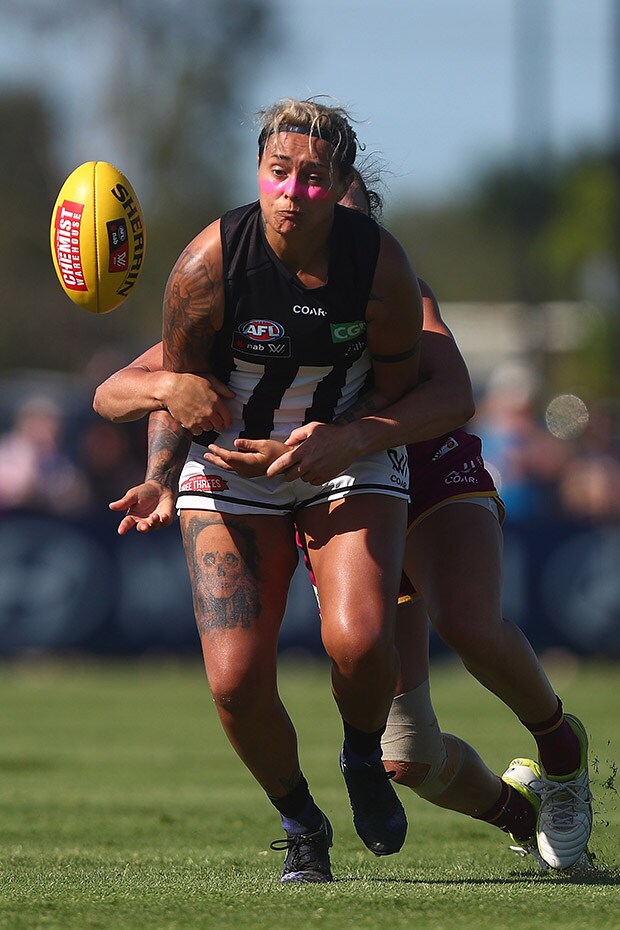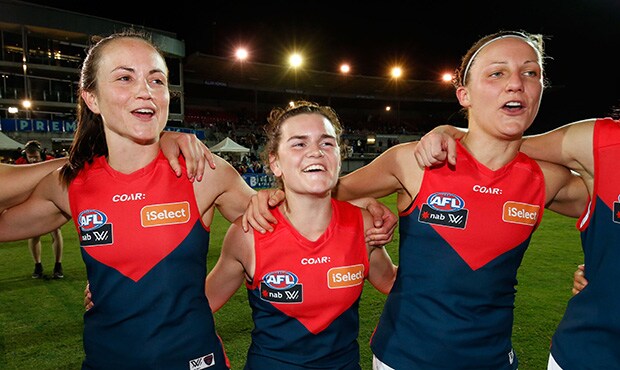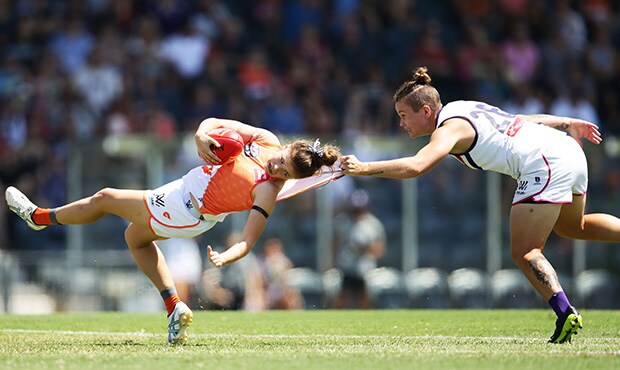AND THEN there were two. After Sunday's top-of-the-table clash between Adelaide and Carlton at Thebarton Oval, only the Crows and the Brisbane Lions remain undefeated after three rounds of the NAB AFL Women's competition. In an extremely physical match, the two teams laid 130 tackles in just over 60 minutes, and it took a big 60m goal from Erin Phillips to get Adelaide over the line.
The Crows, who have showcased a free-flowing style of footy until now, changed up their approach and left the Blues battered and bruised. Key Carlton defenders Brianna Davey and Danielle Hardiman spent much of the third quarter off the ground getting various knocks assessed, and the temporary loss of the two proved to be a turning point in the match.
Match Review Panel: AFLW, round three
Such contact and aggression was simply part and parcel of footy, said AFL Victoria's female talent manager and academy coach Darren Flanigan.
"It's a contact sport - there are going to be injuries," Flanigan said.
"Females who play the game know it's a contact sport, like it because it's a contact sport and have chosen to play it."
Adelaide and the Lions came into the season with question marks over their playing lists – the Crows’ list is split between Adelaide and Darwin, making pre-season and weekly training logistically challenging, and the Lions mostly an unknown quantity outside of Queensland – but have proved doubters wrong to be genuine premiership chances.
Of concern is the fact injuries are starting to pile up across the competition, exacerbated by relatively small playing lists and the short season. Players like Carlton's Natalie Plane, injured in round one with a high-grade ankle sprain, have been ruled out for the season. In a standard 22-round AFL season, she might have played again.
An ACL tear has ended the season of Carlton defender Sarah Last, after she suffered the serious injury against the Crows on Sunday.
Clubs started the season with 27-29 players (some added injury-replacement players pre-season), leaving very little room for injuries. Clubs can replace players ruled out for the season, but only with players in their respective state academy squads.
Hannah Dunn trained with Greater Western Sydney over summer as an injury top-up player, despite not being officially listed. Top-up players can take the field if a club has less than 24 fit players available for selection, as Dunn did in round one.
But as the season progresses, others are likely to have to come into a club "cold", having not completed a pre-season at the elite level, and not knowing many of their new teammates, coaches or the game-plan. That was the case two weeks ago, when the Blues seconded Tahni Nestor from the Victorian academy squad to replace Plane.
Studies around sports such as basketball and European handball have found women have a greater propensity to suffer ACL injuries than men. So far, four players have sustained serious knee injuries (not including marquee players Renee Forth and Kiara Bowers, who suffered their injuries in late 2016).
Other players who have been ruled out for the season with serious injuries include Brianna Green (Fremantle, broken collarbone), Meg Downie (Melbourne, concussion and hamstring tear), Stephanie De Bortoli (Melbourne, torn Achilles). Fremantle's Tiah Haynes dislocated her shoulder in Saturday's loss to Brisbane Lions, with the club yet to confirm the severity of the injury and whether she’ll miss any games.
Flanigan said he was having conversations with Victorian-based clubs about potential top-up players weekly, regardless of whether players were needed immediately.
That confirms clubs are well aware of the limitations of their lists, and have a plan B ready to go at a moment's notice.
With all elements of the inaugural AFLW season under review after the Grand Final, the size of team lists for 2018 will be a major talking point.
Talk about leading by example! @Adelaide_FC co-captain Erin Phillips puts the Crows ahead for the first time today #AFLWCrowsBlues pic.twitter.com/kc8FiY8432
— AFL Women's (@aflwomens) February 19, 2017
What can Collingwood do now?
After its four-point loss to the Brisbane Lions, Collingwood sits bottom of the ladder, winless after three rounds. If the Magpies somehow win all four remaining matches, they are a mathematical chance of making the Grand Final, but also need one of Adelaide or the Lions to lose all of their games. It might be time for some drastic moves.
Collingwood's problems seem to lie in its midfield. Amelia Barden has played well, but has had little support. Defender Meg Hutchins is the team’s best ball-user (81 per cent disposal efficiency after three rounds), and could be moved into the middle to get better delivery into the forward line.
Ruck Lou Wotton has played only one match, but could come in for next week's match against the Bulldogs, potentially freeing up Emma King to provide a bigger target in the forward line. This could also draw a second defender away from Moana Hope, who has been frustrated by double-teaming in the first three weeks.
Star Pie Moana Hope has struggled to escape opposition defenders. Picture: AFL Photos
Melbourne's most important player is not who you think it is
Melbourne captain Daisy Pearce is clearly one of the best players in the game, and has been since she was picked No.1 overall for the first AFL exhibition matches in 2013. But she is not necessarily the Demons' most important player, despite finishing with 26 disposals in their win over the Bulldogs.
Karen Paxman lines up alongside Pearce in the middle, and is a key cog in Melbourne's midfield. Paxman, a priority selection, is third in the competition for average disposals per game (22 in a 60-minute game) and fifth for total clearances (11 in three matches). With opponents devoting a lot of time to limiting Pearce's influence, Paxman has been able to assert herself. To beat Melbourne, teams will have to shut both players down.
(L-R) Daisy Pearce, Lily Mithen and Karen Paxman celebrate a Demons win. Picture: AFL Photos
Fremantle's jumper shocker
Fans were seeing double at Blacktown after both Greater Western Sydney and Fremantle ran out wearing predominately white jumpers and white shorts. The Dockers had been told to wear their home strip – purple with white chevrons and purple shorts – but packed their away strip – white with purple chevrons and white shorts – instead.
A Giants official made a mad dash to the club's headquarters at Homebush in the first quarter, and the team changed into charcoal shorts at quarter-time. Despite this, the similar jumpers continued to cause confusion, with both teams having white backs with dark numbers (purple and grey).
Fremantle national women's league, academies and community manager Wade Spilcker apologised for the mix-up, which he described as an "operational error".
The AFL reviewed the matter on Monday and fined the Dockers $10,000 ($5000 suspended).
It wasn't the only uniform issue the Dockers had in Sydney. A missing jumper led to a number swap to accommodate different sizes. Midfielder Taylah Angel changed numbers pre-game from No.9 to No.26 (officially allocated to Beatrice Devlyn, who wasn’t playing), with debutant forward Kira Phillips, listed as No.13, taking Angel's No.9.
All white, all white, all white: The Giants and Dockers made it hard for viewers. Picture: AFL Photos
Strange but true
Saturday's draw between GWS and Fremantle was the first in the AFLW competition, with both teams finishing on 43 points. Curiously, in the first draw in the VFL competition – 120 years ago, in 1897 – Fitzroy and South Melbourne also finished on 43 points apiece.
43-43 for @freodockers v @GWSGIANTS
— Joshua Kay (@js_kay) February 18, 2017
Same score as first draw in VFL
Fitzroy v Sth Melbourne
Rd 7, 1897#AFLW


